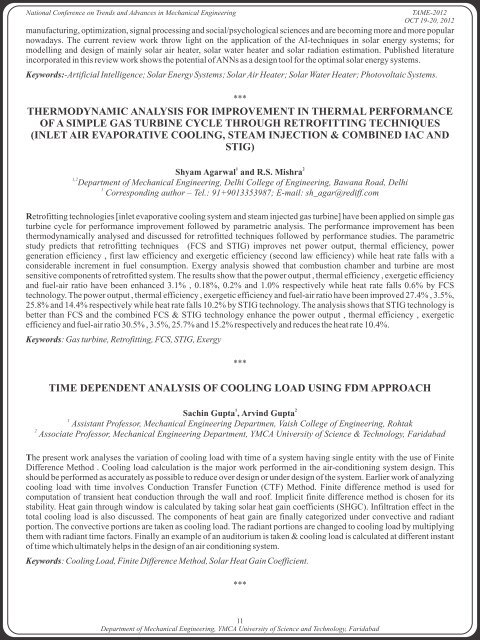Souvenir Containing Abstracts - YMCA University of Science ...
Souvenir Containing Abstracts - YMCA University of Science ...
Souvenir Containing Abstracts - YMCA University of Science ...
You also want an ePaper? Increase the reach of your titles
YUMPU automatically turns print PDFs into web optimized ePapers that Google loves.
National Conference on Trends and Advances in Mechanical Engineering<br />
TAME-2012<br />
OCT 19-20, 2012<br />
manufacturing, optimization, signal processing and social/psychological sciences and are becoming more and more popular<br />
nowadays. The current review work throw light on the application <strong>of</strong> the AI-techniques in solar energy systems; for<br />
modelling and design <strong>of</strong> mainly solar air heater, solar water heater and solar radiation estimation. Published literature<br />
incorporated in this review work shows the potential <strong>of</strong> ANNs as a design tool for the optimal solar energy systems.<br />
Keywords:-Artificial Intelligence; Solar Energy Systems; Solar Air Heater; Solar Water Heater; Photovoltaic Systems.<br />
***<br />
THERMODYNAMIC ANALYSIS FOR IMPROVEMENT IN THERMAL PERFORMANCE<br />
OF A SIMPLE GAS TURBINE CYCLE THROUGH RETROFITTING TECHNIQUES<br />
(INLET AIR EVAPORATIVE COOLING, STEAM INJECTION & COMBINED IAC AND<br />
STIG)<br />
1 2<br />
Shyam Agarwal and R.S. Mishra<br />
1,2<br />
Department <strong>of</strong> Mechanical Engineering, Delhi College <strong>of</strong> Engineering, Bawana Road, Delhi<br />
1<br />
Corresponding author – Tel.: 91+9013353987; E-mail: sh_agar@rediff.com<br />
Retr<strong>of</strong>itting technologies [inlet evaporative cooling system and steam injected gas turbine] have been applied on simple gas<br />
turbine cycle for performance improvement followed by parametric analysis. The performance improvement has been<br />
thermodynamically analysed and discussed for retr<strong>of</strong>itted techniques followed by performance studies. The parametric<br />
study predicts that retr<strong>of</strong>itting techniques (FCS and STIG) improves net power output, thermal efficiency, power<br />
generation efficiency , first law efficiency and exergetic efficiency (second law efficiency) while heat rate falls with a<br />
considerable increment in fuel consumption. Exergy analysis showed that combustion chamber and turbine are most<br />
sensitive components <strong>of</strong> retr<strong>of</strong>itted system. The results show that the power output , thermal efficiency , exergetic efficiency<br />
and fuel-air ratio have been enhanced 3.1% , 0.18%, 0.2% and 1.0% respectively while heat rate falls 0.6% by FCS<br />
technology. The power output , thermal efficiency , exergetic efficiency and fuel-air ratio have been improved 27.4% , 3.5%,<br />
25.8% and 14.4% respectively while heat rate falls 10.2% by STIG technology. The analysis shows that STIG technology is<br />
better than FCS and the combined FCS & STIG technology enhance the power output , thermal efficiency , exergetic<br />
efficiency and fuel-air ratio 30.5% , 3.5%, 25.7% and 15.2% respectively and reduces the heat rate 10.4%.<br />
Keywords: Gas turbine, Retr<strong>of</strong>itting, FCS, STIG, Exergy<br />
***<br />
TIME DEPENDENT ANALYSIS OF COOLING LOAD USING FDM APPROACH<br />
1 2<br />
Sachin Gupta , Arvind Gupta<br />
1<br />
Assistant Pr<strong>of</strong>essor, Mechanical Engineering Departmen, Vaish College <strong>of</strong> Engineering, Rohtak<br />
2<br />
Associate Pr<strong>of</strong>essor, Mechanical Engineering Department, <strong>YMCA</strong> <strong>University</strong> <strong>of</strong> <strong>Science</strong> & Technology, Faridabad<br />
The present work analyses the variation <strong>of</strong> cooling load with time <strong>of</strong> a system having single entity with the use <strong>of</strong> Finite<br />
Difference Method . Cooling load calculation is the major work performed in the air-conditioning system design. This<br />
should be performed as accurately as possible to reduce over design or under design <strong>of</strong> the system. Earlier work <strong>of</strong> analyzing<br />
cooling load with time involves Conduction Transfer Function (CTF) Method. Finite difference method is used for<br />
computation <strong>of</strong> transient heat conduction through the wall and ro<strong>of</strong>. Implicit finite difference method is chosen for its<br />
stability. Heat gain through window is calculated by taking solar heat gain coefficients (SHGC). Infiltration effect in the<br />
total cooling load is also discussed. The components <strong>of</strong> heat gain are finally categorized under convective and radiant<br />
portion. The convective portions are taken as cooling load. The radiant portions are changed to cooling load by multiplying<br />
them with radiant time factors. Finally an example <strong>of</strong> an auditorium is taken & cooling load is calculated at different instant<br />
<strong>of</strong> time which ultimately helps in the design <strong>of</strong> an air conditioning system.<br />
Keywords: Cooling Load, Finite Difference Method, Solar Heat Gain Coefficient.<br />
***<br />
11<br />
Department <strong>of</strong> Mechanical Engineering, <strong>YMCA</strong> <strong>University</strong> <strong>of</strong> <strong>Science</strong> and Technology, Faridabad













